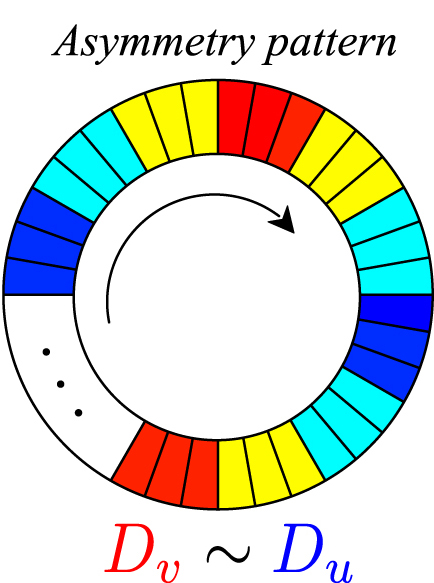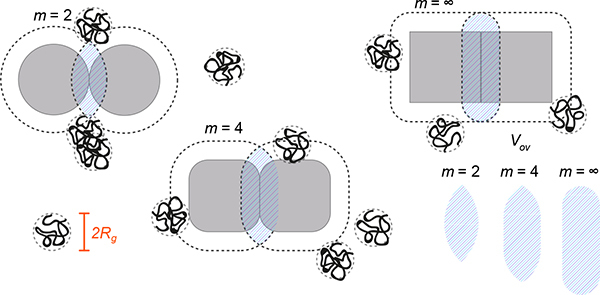News
EPJ B Colloquium - Understanding nonequilibrium scaling laws governing collapse of a polymer
- Details
- Published on 03 September 2020
Recent emerging interest in experiments of single-polymer dynamics have encouraged computational physicists to revive their understanding of these phenomena, particularly in the nonequilibrium context. In a Colloquium recently published in EPJB, authors from Institut für Theoretische Physik at the University of Leipzig discuss the currently evolving approaches of investigating the evolution dynamics of homopolymer collapse using computer simulations.
EPJ D Colloquium - Simulating lattice gauge theories within quantum technologies
- Details
- Published on 17 August 2020
EPJ D Highlight - Measuring electron emission from irradiated biomolecules
- Details
- Published on 06 August 2020

OrigiA new experiment has characterised the properties of the electrons emitted when a key constituent of DNA is bombarded with high-velocity ions.
When fast-moving ions cross paths with large biomolecules, the resulting collisions produce many low-energy electrons which can go on to ionise the molecules even further. To fully understand how biological structures are affected by this radiation, it is important for physicists to measure how electrons are scattered during collisions. So far, however, researchers’ understanding of the process has remained limited. In new research published in EPJ D, researchers in India and Argentina, led by Lokesh Tribedi at the Tata Institute of Fundamental Research, have successfully determined the characteristics of electron emission when high-velocity ions collide with adenine – one of the four key nucleobases of DNA.
EPJ B Highlight - Updating Turing’s model of pattern formation
- Details
- Published on 03 August 2020

Through fresh analysis of a method first proposed by Alan Turing to explain the diversity of natural patterns, a team of researchers offer new explanations of how living systems can order themselves on large scales.
In 1952, Alan Turing published a study which described mathematically how systems composed of many living organisms can form rich and diverse arrays of orderly patterns. He proposed that this ‘self-organisation’ arises from instabilities in un-patterned systems, which can form as different species jostle for space and resources. So far, however, researchers have struggled to reproduce Turing patterns in laboratory conditions, raising serious doubts about its applicability. In a new study published in EPJ B, researchers led by Malbor Asllani at the University of Limerick, Ireland, have revisited Turing’s theory to prove mathematically how instabilities can occur through simple reactions, and in widely varied environmental conditions.
EPJ Plus Focus Point on Nanotechnology, Nanomaterials and Interfaces
- Details
- Published on 24 July 2020

The Special Issue contains the articles which were presented at the International research and practice conference “Nanotechnology and Nanomaterials” (NANO-2018), which was organized by the Institute of Physics of NAS of Ukraine with the participation of the Yuriy Fedkovych Chernivtsi National University (Ukraine), University of Tartu (Estonia), University of Turin (Italy), Pierre and Marie Curie University – Paris 6 (France).
The Special Issue gathered high-level articles at the forefront of nanoscience research which is devoted to: the optical absorption by a nanosystem with dielectric quantum dots; the fabrication of crystalline Bi2TeO5 - Bi4Si3O12 - SiO2 nanocomposite; the existence of both size and “even-odd” effects for the lifetime of carbyne-based nanodevices consisting of two graphene sheets connected by a carbyne chain; the adsorption properties of the silica-titanium mixed oxide; the adsorption properties and application perspectives of BSA films as sensitive coatings for gas sensors; the properties of MgFe2O4; to the problem of band broadening of SPR; the structural studies concerning the formation of self-assembled indium deposited nanostructures on the (100) surface of In4Se3 layered semiconductor and the possibility of constructing the general dynamic properties of a conduction electron injected into graphene in the rectangular lattice approximation.
The Guest Editor, Olena Fesenko, hopes that this collection provides a quick overview on recent trends in this emerging field of research.
Michel Calame joins the EPJ Scientific Advisory Committee (SAC)
- Details
- Published on 23 June 2020

The Scientific Advisory Committee of EPJ is delighted to welcome Professor Michel Calame as the new representative for the Swiss Physical Society.
Michel Calame is head of the Transport at Nanoscale Interfaces Laboratory at the Swiss Federal Laboratories for Materials Science and Technology (Empa) and Professor of Nanoscience at the University of Basel in Switzerland.
His expertise is in nano- and molecular scale electronics and in the quantum transport properties of heterogeneous nano-scale devices. He served as a board member of the Maths, Astronomy and Physics Platform at the Swiss Academy of Sciences from 2007 to 2012 and was the head of the Swiss Nanoscience Institute PhD School from 2013 until 2016.
EPJ E Highlight - Polymers can fine-tune attractions between suspended nanocubes
- Details
- Published on 19 June 2020

Interactions between hollow silica nanocubes suspended in a solution can be adjusted by varying the concentration of polymer molecules added to the mixture.
Colloids are complex mixtures in which microscopic particles of one substance are suspended evenly throughout another. They can be prepared in many different ways, but to achieve desirable properties in the final mixture, researchers must maintain a delicate control over the interactions which take place between the particles. In new research published in EPJ E, a team led by Remco Tuinier at the Eindhoven University of Technology in the Netherlands demonstrate this level of control for a type of colloid in which the suspended particles take the form of hollow, nanoscale cubes – a case which has only previously been explored through theoretical calculations.
EPJ B Highlight - Skyrmion dynamics and traverse mobility
- Details
- Published on 19 June 2020

Skyrmions could revolutionise computing exhibiting great potential in the electronic storage of information, and the key to such a breakthrough could be understanding their behaviour under applied currents.
As the demands on information technology increase, the need to improve the storage of data also grows. Many solid-state systems suggested for such a task are founded on the manipulation of skyrmions, perfect for such a role due to their size and stability. In a study published in EPJ B, authors N.P. Vizarim and C.J.O. Reichhardt from the Theoretical Division and Center for Nonlinear Studies, Los Alamos National Laboratory, New Mexico, USA and their colleagues aim to understand how skyrmions behave in a substrate under dc and ac drives.
EPJ B Highlight - Simulating cooperation in local communities
- Details
- Published on 12 June 2020

Simulations reveal how the social benefits of supplies to goods and service providers in China could be improved through a payoff transfer system, which rewards individuals who cooperate the most with their local communities.
Many goods and service providers in China rely on supplies from local governments, but these are often limited by financial budgets – especially in rural villages. Members of the public must cooperate with their governments and each other in order for this system to run smoothly, but unfortunately, this balance is threatened by a small proportion of individuals who take in welfare without contributing fairly to their communities. In new research published in EPJ B, Ran Yang and colleagues at Tianjin University, China, introduce a new simulation-based approach which could help to solve this issue, through a cost-effective system which rewards individuals who use welfare systems responsibly.
EPJ D Topical review - Wigner scattering theory for systems held together by Coulombic forces
- Details
- Published on 11 June 2020

Originally developed and formulated for nuclear scattering, Wigner’s theory is extremely general, with application in many branches of physics. Atomic Physics often makes use of an apparently separate formalism (MQDT) which is in fact a specialisation of Wigner’s theory. In a new Topical Review article published in EPJD, Jean-Patrick Connerade (Imperial College London, UK and and European Academy EASAL, France) discusses the relevance of Wigner Scattering theory and in particular its K-matrix formulation for all systems held together by coulombic forces, including not only atoms and molecules but also clusters.





